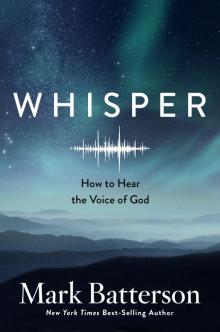- Home
- Mark Batterson
Whisper Page 4
Whisper Read online
Page 4
He’s big enough to speak through doors and dreams and people.
He’s close enough to speak through desires and promptings and pain.
Closer Than Close
Long before the Holy Spirit filled or stirred or gifted or convicted or sealed or revealed or reminded, we find Him hovering over the surface of the deep.35 And He is still hovering over our lives the way He hovered over creation.
He still speaks light into darkness.
He still brings order out of chaos.
He still makes beauty out of ashes.
The Hebrew word used to describe God’s proximity is paniym, and it’s multidimensional. In regard to time, paniym refers to the split second before and the split second after—a parenthesis in time. In regard to space, paniym refers to the place right in front and right in back—a parenthesis in space.
He is God with us in every sense of the word.
He is a friend that sticks closer than a brother!
A. W. Tozer pictured paniym this way: “God is above, but He’s not pushed up. He’s beneath, but He’s not pressed down. He’s outside, but He’s not excluded. He’s inside, but He’s not confined. God is above all things presiding, beneath all things sustaining, outside of all things embracing and inside of all things filling.”36
The Holy Spirit is hovering. The Holy Spirit is whispering. The Holy Spirit is breathing into you the same breath He breathed into the dust bowl named Adam.
Remember the bravest prayer that I prayed? For the first few weeks, I wasn’t sure whether or not I was healed of my asthma, so I asked God to confirm it somehow, someway. More specifically, I asked Him for a word from His Word, and He gave me just that. I didn’t, however, expect it to be one word or an Aramaic word: “Ephphatha!”37 It means “Be opened!” and it’s the one word Jesus used to heal a man with a speech impediment. Scripture says that when the man’s ears were opened, his tongue was untied, and he spoke plainly. Notice the sequence.
Is it possible Jesus knew that speech problems were hearing problems long before Dr. Alfred Tomatis came along? Well, Dr. Tomatis himself cited this miracle of Jesus as the confirmation of his conclusion that the mouth can speak only what the ear can hear.38
The focus of this chapter has been on the power of God’s voice. God created galaxies with four words! And evidently He can open deaf ears with one word. Just as Jesus opened this man’s ears with one word, he opened my lungs. And that word has become one of my favorite words.
Along with asking God for a confirmation of healing, I started researching anything and everything related to respiration. I’m not sure how this theory stayed hidden from me through three seminary degrees, but it has forever changed the way I think about the twenty-three thousand breaths we take every day.39 Some Hebrew scholars believe that the name of God, Yahweh—or without the vowels, YHWH—is synonymous with the sound of a breath. On one hand, the name is too sacred to pronounce. On the other hand, it’s whispered with each and every breath we take. It’s our first word, our last word, and every word in between.
God is as close as the breath we breathe.
Catholic priest Desiderius Erasmus coined the Latin phrase vocatus atque non vocatus, Deus aderit. Translation: “Bidden or not bidden, God is here.” The Swiss psychiatrist Carl Jung engraved those words above the door of his home.40 Not unlike the Jewish custom of engraving the words of the Shema on the doorposts of one’s home, that simple statement served as a constant reminder of God’s presence: omnipresence.
Scripture paints the picture of a God who exists outside of time—the One who was, who is, who is to come. It paints the picture of a God who exists outside of space—the One who is here, there, and everywhere.
But there is one place where God finds Himself on the outside looking in, and that place is the door to your heart. If you want to hear His voice, you have to answer the knock.
By Invitation Only
In 1853 English artist William Holman Hunt painted a portrait of Jesus standing at a door and knocking. He called it The Light of the World, and it’s a visual representation of Revelation 3:20: “I stand at the door and knock. If anyone hears my voice and opens the door, I will come in and eat with that person, and they with me.”
Fifty years later Hunt said that it was more than a painting. It was a prompting, a divine command.41 One fascinating feature of the painting is that the door has no handle on the outside, and it was left off intentionally. Why? Because the door to the heart is opened only from the inside. God enters by invitation only. And that’s not just true of Jesus; it’s true of the Holy Spirit too.
I recently spoke at a pastors’ conference in England. It was my first time speaking to our compatriots across the pond, so I wasn’t entirely sure what to expect. I think I was subliminally influenced by the series Downton Abbey, thinking the setting might be somewhat formal, somewhat ascetic. But what I encountered was so life giving that I wished I could bottle that experience and uncork it in the church I pastor.
One simple practice left a lasting impression on me, and it’s a mainstay in the Anglican tradition. It’s the recitation of the simplest of prayers: Come, Holy Spirit. The Latin phrase Veni Creator Spiritus may have originated with a ninth-century hymn written by a Benedictine monk, Rabanus Maurus. Since the English Reformation in the sixteenth century, there have been more than fifty translations. But the version included in the 1662 revision of The Book of Common Prayer is this:
Come, Holy Ghost, our souls inspire,
and lighten with celestial fire.
Thou the anointing Spirit art,
who dost thy sevenfold gifts impart.
This prayer was prayed over King Charles I at his coronation in 1625, and the very same prayer has been prayed at the coronation of every English monarch since. Those words are sung by the coronation choir after the singing of the Creed, while the king or queen is seated in the Coronation Chair, just prior to the anointing.42
You don’t have to tell the Holy Spirit when or where or how to come, but you should extend an invitation. This prayer is not an “abracadabra.” The danger with any repeated prayer is that it can become an empty incantation. But if you pray it and really mean it, don’t be surprised if the Holy Spirit shows up and shows off in some strange and mysterious ways!
And remember, it won’t really be God speaking any louder than He already is. It’ll be you listening a little closer, a little better.
Maybe this is your bravest prayer?
THE WHISPERING SPOT
So is my word that goes out from my mouth.
—ISAIAH 55:11
In March of 1792, Secretary of State Thomas Jefferson announced a competition awarding five hundred dollars and a city lot to whoever produced “the most approved plan” for the United States Capitol. None of the seventeen plans submitted were accepted. After the competition closed, a Scottish-trained physician living in the British West Indies, Dr. William Thornton, requested permission to submit a proposal, and his plans were ultimately accepted. The amateur architect became known as the “first architect” and, a decade later, the first superintendent of the United States Patent Office.1
The year after Thornton submitted his Capitol plan, President George Washington led a parade of people to Jenkins Hill, now Capitol Hill. With music playing, drums resounding, colors flying, and spectators celebrating, the cornerstone of the Capitol was laid on September 18, 1793. It was consecrated with corn, wine, and oil. And the festivities concluded with a five-hundred-pound ox being butchered, setting a precedent for one of America’s most sacred rituals: the barbecue!2
With two hundred twenty-five years of history under its belt, the Capitol is perhaps the most storied structure in America. The decisions made, actions taken, and conversations had within those hallowed halls have altered the course of history time and time again. If those walls could talk, they would tell of public hearings and private conv
ersations, floor debates and committee votes, that have forged this nation.
It was there, on May 24, 1844, that Samuel Morse tapped the first long-distance telegraph message, “What hath God wrought!” Morse’s prototype had sent messages between the House and Senate wings of the Capitol, but those dots and dashes traveled thirty-eight miles to a train depot in Baltimore, Maryland, revolutionizing communication in a way that wouldn’t be felt again until the invention of the telephone or the advent of e-mail and the Internet.3
It was there, on March 3, 1865, that Abraham Lincoln, while signing end-of-the-session legislation in the president’s room, first learned of the South’s desire to surrender. The very next day Lincoln delivered his second inaugural address, “with malice toward none; with charity for all,” from the East Portico.4 And six weeks later our sixteenth president was laid in state in the Capitol rotunda, the victim of John Wilkes Booth’s .44-caliber bullet.
It was there, on December 8, 1941, that Franklin Delano Roosevelt rallied a grief-stricken nation the day after “a date which will live in infamy.”5 After he delivered that speech to a joint session of Congress, America declared war on Japan for its unprovoked attack on Pearl Harbor and entered the Second World War.
For the past twenty years, I’ve lived precisely one mile from the Capitol. I can see the Statue of Freedom sitting atop the cast-iron dome from our home. We picnic at the Capitol in the summer and sled there in the winter. Yet despite the fact that I drive by it or run around it nearly every day, it never gets old. In fact, I probably look like a run-of-the-mill tourist when I fly in or out of Reagan National Airport, because I still take pictures. It’s as beautiful as the day I first laid eyes on it.
Over the years I’ve found a few favorite spots within the Capitol. The view from the Senate chaplain’s office is spectacular—a panorama of the National Mall and its monuments through a window that looks like the cockpit window of the Millennium Falcon. Standing in the middle of the eight larger-than-life paintings that encircle the Capitol rotunda is absolutely awe inspiring, and it’s worth noting that the artwork depicts a Bible study aboard the Mayflower, the baptism of Pocahontas, and perhaps the first prayer meeting in the New World.6
But to me the most inspiring place of its 540 rooms that span four acres is Statuary Hall. It’s a two-story semicircular room in the Old Hall, where the House of Representatives first convened on November 17, 1800. Standing over the entrance is a marble sculpture, the Car of History, depicting Clio, the muse of history, holding a book in which she chronicles events as they occur.7
In 1864 Congress invited each state to nominate two prominent citizens for permanent display in the Capitol. Thirty-eight of the now one hundred statues stand guard in Statuary Hall. They include Philo T. Farnsworth of Utah, the inventor of the television; Thomas Edison of Ohio, the holder of 1,093 US patents; Rosa Parks and Helen Keller of Alabama, who broke racial and disability barriers; Jacques Marquette of Wisconsin, the Jesuit missionary who mapped the Mississippi River; and Sacagawea of North Dakota, the Shoshone heroine who helped Lewis and Clark explore the Louisiana Purchase.
Walking into Statuary Hall is like walking into the Who’s Who of American history, surrounded by a great cloud of witnesses. But let me tell you about my favorite place within my favorite room: the whispering spot.
Whispering Waves
When I first toured the Capitol more than two decades ago, our guide revealed a secret that wasn’t really a secret: the whispering spot. He stood on one side of Statuary Hall while our tour group stood on the other side. Then he spoke in a whisper, and sure enough, we could mysteriously and miraculously hear the echo of his voice all the way across the room as if he were mere inches away.
A few tall tales have been told over the years, such as the story of John Quincy Adams pretending to be asleep at his desk while eavesdropping on political opponents. Those stories can’t be corroborated, but the physics can. The circular walls and domed ceiling of Statuary Hall allow whispering waves to travel the circumference of the room in unusual ways.
I don’t know if Dr. William Thornton intended that acoustical effect, and because of the altered configuration of the room, the echoes actually occur in different places now than they did when it was the House Chamber. But the reality is this: if you stand in the right spot, you can hear a quiet whisper all the way across the room, even if it’s noisy. And that’s true even in the month of May, when it seems every eighth grader in America visits the nation’s capital on a class trip.
When I look through the Bible, I see whispering spots everywhere.
For Abraham, it was the oak of Mamre.8
For Isaac, it was the well outside Nahor.9
For Jacob, it was Bethel.10
For Moses, it was a burning bush.11
For Joshua, it was Gilgal.12
For Gideon, it was the oak tree in Ophrah.13
For Samuel, it was the tabernacle at Shiloh.14
For David, it was the cave of Adullam.15
For Elijah, it was Mount Carmel.16
For Mordecai, it was the king’s gate at the citadel of Susa.17
For Ezekiel, it was the Kebar River.18
For Daniel, it was an upstairs window facing Jerusalem.19
For Jonah, it was the belly of a whale.20
Let me be clear about one thing before we go any further: God can show up anywhere, anytime, anyhow. In fact, that may be why God appeared to Moses the way He did. If I had written the script, I probably would have used the pyramids as a prop, but God chose a burning bush on the back side of the desert. Why? According to rabbinic teaching, it was to show that no place is devoid of God’s presence.
Yes, God’s presence was uniquely manifested between the cherubim’s wings above the ark of the covenant in the Holy of Holies on the Day of Atonement. But if you think God is confined to a chronological day or a geographical location, you’ve put God in a box—even if that box is the ark of the covenant. Don’t use the Bible to box God in.
I know there are those who believe that God speaks only through Scripture. It’s a well-meaning mistake that’s often perpetrated by those who hold a high view of Scripture, as I do. I certainly believe that the Bible is in a category by itself as the inspired Word of God and that the canon is closed. But we actually undermine Scripture’s authority when we discredit God’s ability to speak to us now in the same ways He did in the pages of the Bible.
When I survey Scripture, I see God showing up in strange places, at strange times, in strange ways. And I don’t think anything has changed. God certainly won’t contradict Himself, but He is still predictably unpredictable!
He still turns appointments into divine appointments. He still uploads desires, opens doors, and inspires dreams. He still speaks through promptings and people and pain. And just as he did for Moses, He can turn any patch of ground into holy ground.
Kneeholes
In 1940 Dr. J. Edwin Orr took a group of Wheaton College students to study abroad in England. One of their stops included the Epworth Rectory. The rectory now serves as a Methodist museum, but it was the home of John Wesley, the founder of the Methodist movement.
In one of the bedrooms, there are two impressions where it is believed that John Wesley regularly knelt in prayer. As the students were getting back on the bus, Dr. Orr noticed that one student was missing. Going back upstairs, Dr. Orr found a young Billy Graham kneeling in those kneeholes and praying, “O Lord, do it again!”21
I live by a simple maxim: if we do what they did in the Bible, God will do what He did. He still speaks. He still heals. He still delivers. He still whispers. And there is nothing God wants to do more than to “do it again.” And again, and again, and again. Of course, we must posture ourselves the way John Wesley did, the way Billy Graham did.
We’ll talk about the language of desires soon enough, and I don’t want us to get ahead of ourselves. But do
you remember how John Wesley came to faith in Christ? He claimed that his heart was “strangely warmed” at a place called Aldersgate.22 That sounds awfully subjective, doesn’t it? But that divinely inspired feeling is a testament to the God who speaks to us at the level of emotion, and there is biblical precedent for it.
Remember the disciples who were walking from Jerusalem to Emmaus after Jesus’s crucifixion and resurrection? Jesus was walking with them, was talking with them. Yet they didn’t recognize Him. That might be difficult to imagine, but they didn’t have a category for resurrection. Plus, their faces were “downcast.”23 When we’re in an emotional funk, we often miss what is right in front of our faces. It wasn’t until Jesus did what they had seen Him do before—take bread, give thanks, and break it—that His identity was revealed to them.
Do you remember what they said to each other after the fact?
Were not our hearts burning within us while he talked with us on the road and opened the Scriptures to us?24
Just because something isn’t in the Bible doesn’t make it unbiblical. By unbiblical, I mean contrary to the teachings of Scripture. There is another category—abiblical—and this carries a very different connotation. It simply means that there is no precedent in Scripture.
Does that make it unbiblical? Not necessarily. There is no precedent for pulpits or hymnals or devotionals. But as long as the methodology doesn’t contradict orthodox theology, we’re on good ground. We might even be on holy ground.
We shouldn’t make decisions based solely on emotion, but we shouldn’t ignore emotion either. In fact, one of the best ways to gauge the will of God is to discern whether or not the peace of Christ is ruling in your heart.25 And that requires emotional intelligence. God even speaks through emotions that we can’t put into words, such as the peace that passes understanding and joy unspeakable.26
A Pierced Ear
“Whoever has ears, let them hear.”27 Six times in the Gospels and eight times in the book of Revelation, Jesus repeats these six words. It’s the simplest of statements, but the implications are exponential. The exhortation is urgent, and I believe your destiny depends on it.

 Jack Staples and the Ring of Time
Jack Staples and the Ring of Time Jack Staples and the City of Shadows
Jack Staples and the City of Shadows Jack Staples and the Poet's Storm
Jack Staples and the Poet's Storm Whisper
Whisper The Circle Maker_Praying Circles Around Your Biggest Dreams and Greatest Fears
The Circle Maker_Praying Circles Around Your Biggest Dreams and Greatest Fears